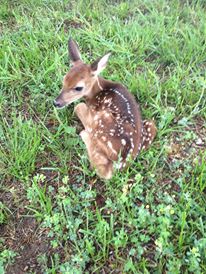What To Do When You Find A White-tailed Fawn
Filed under: Hunting Blog, White-tailed Deer
Have you ever found a fawn? This is the time of year throughout most of the whitetail’s range that fawns are born! Does typically have fawns in areas of low cover if such habitat is available. This includes areas where turkey hunters might expect to see late season toms trolling for hens. Good turkey nesting habitat is usually good fawning habitat. If such cover isn’t available in an area, does will fawn in fields, yards, along trails, etc.
These are areas that folks frequent and therefore find fawns. I receive a lot of questions each spring about what to do if a fawn is found. Rarely will the doe be seen near the fawn so it’s a logical assumption that the fawn has been abandoned.
That’s rarely the case! Does leave their fawns for hours at a time and only return to the fawn to allow them to nurse during the first few weeks after giving birth. This reduces the amount of scent and movement around the newborn fawns and scientists assume this serves to reduce predation of fawns.
If you find a fawn, snap a quick picture if you please and then simply leave the area. The doe may be watching you, but will rarely show herself. Your scent could serve to attract predators so do the same as the doe and leave the area.
It’s illegal in most states to possess wild, free-ranging living wildlife. In addition, fawns do best when they can feed on their mother’s milk. If you find a fawn at the edge of your yard, keep your pets penned up and it’s likely the doe will move the fawn soon due to the amount of disturbance in that environment. If you find a fawn away from civilization, simply keep moving.
I really enjoy watching all ages of deer. However, when it comes to newborn fawns, I take a quick look and picture, then back out of the area. That’s the best action that can be taken!
Enjoying Deer together,
Grant




